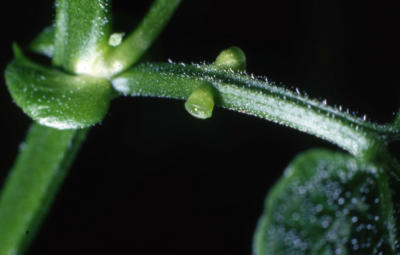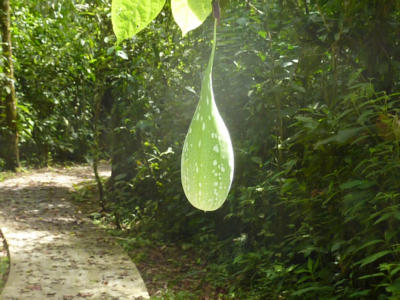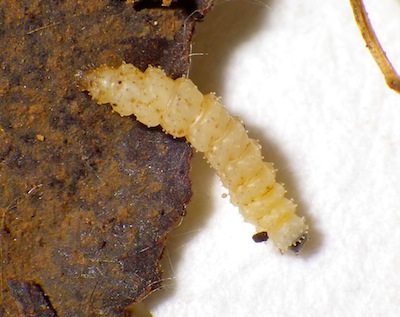Passiflora lobata
P. lobata is one of the most common forest edge, and forest tree fall gap species of Passiflora at La Selva. It is very fast growing and more likely to flower, fruit and set seeds than most other species. The stems are triangular in cross-section. Its leaves are covered with tiny velcro-like hooked trichomes that kill soft-bodied caterpillars, including most species of Heliconius. The exception is Heliconius charithonia, whose cuticle allows it to walk across the hooks unharmed (Gilbert 1971). These trichomes do not seem to have any effect on adult flea beetles, who find this to be one of their favorite host plants. P. lobata is the most likely Passiflora to be defoliated by flea beetles, and plants often die after being "infected" by groups of flea beetles. This species has the greatest rate of demographic turnover of any species at La Selva, and few P. lobata live longer than 1-2 years.
P. lobata belongs in subgenus Decaloba, supersection Bryonioides. Range: not widely distributed, from Nicaragua to NW Colombia; 0-1,700 meters elevation in edges and in treefall openings in wet forest.. Its relative P. adenopoda, also possessing hooked trichomes on the leaves, is more widely distributed, from Mexico to Peru. Many of the species in this supersection are from seasonally dry forest habitats in Mexico where they die back in the dry season.
Heliconius charithonia at La Selva preferentially uses P. lobata as host, laying 10-15 eggs on the new foliage. These hatch and the larvae feed together, growing rapidly. In other regions such as the southern United States, and also in highly disturbed areas such as pastures and towns (and captive greenhouse colonies), H. charithonia lays eggs singly on many other species of Passiflora. This butterfly may thus be described as "facultatively" monophagous on P. lobata (Gilbert and Smiley 1978).
P. lobata is fed upon by many flea beetles, including the Blue Flea Beetle (Monomacra violacea), the Red-White Flea Beetle (Ptocadica "Red"), and to a much lesser extent, the Yellow-legged Flea Beetle (Parchicola DF2). P. lobata also appears to be the primary host for larvae of M. violacea. In one instance I found several of the Red-black Flea Beetles Monomacra chontalensis on a forest P. lobata plant. Perhaps there was a successful hatching on that plant? The Blue flea beetle (Monomacra violacea) can build up numbers on larger plants in 2-3 months, enough to kill the plant. The plant may die from having its basal stems severed by feeding larvae of this beetle. Red Ptocadica may also defoliate smaller plants, perhaps also leading to plant death.
Red Ptocadica seems to be somewhat of a specialist on P. lobata, with 95% of sightings from that plant, including larvae. It is interesting to note that its larvae feed readily on P. lobata, but larvae of Red Pedilia, a specialist on Passiflora pittieri not normally found on P. lobata, die on the hooks. Thus, the hooked trichomes can be a deterrent to some flea beetle larvae as well as butterfly caterpillars. It would be very interesting to see if presumably non-adapted Ptocadica bifasciata larvae die on the hooks as well.
Like P. oerstedii and P. vitifolia, P. lobata leaves do not produce measureable amounts of cyanide when crushed. The related P. adenopoda is reported by Spencer (1988) and Engler (2007) as containing aliphatic cyanogens, the class which includes linamarin and lotustralin. Perhaps, like P. oerstedii, P. lobata contains the cyanogen in measureable amounts, but lacks the appropriate beta-glucosidase enzyme. P. lobata rootlets produce small but measurable amounts of HCN when crushed (0.1 to 0.01 μM/g wet weight), but the release is unusually slow (>>1 hour).

The large petiolar nectaries are attractive to ants such as Ectatomma sp.

It is one of the most commonly found wild passion fruits at La Selva.
